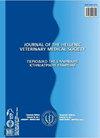Effects of In-Ovo Glucose and Glutamine Treatment on Hatching Efficiency, Intestinal Histomorphology and Gene Expression of Digestive Enzymes in Broiler Chicks
IF 0.4
4区 农林科学
Q4 VETERINARY SCIENCES
引用次数: 0
Abstract
The purpose of the present study was to identify the effects of in-ovo injection of glucose and glutamine on hatching efficiency, hatching weight, liver and residual yolk weights, intestinal histomorphology and gene expressions of digestive enzymes. On the 17th day of incubation, NaCl (0.9 %), glutamine (0.5 ml 10%), glucose (0.5 ml 0.25 g/ml), and glutamine+glucose (0.25 ml 10%+0.25 ml 0.25 g/ml) were injected into the amniotic sac. In-ovo injection of glucose, glutamine and glucose+glutamine significantly decreased hatching efficiency in glucose and glutamin+glucose groups (p<0.001). This treatment did not affect hatching weight, liver and residual yolk weight in any of the groups. When the intestinal histomorphology was evaluated, in-ovo injection was found to increase the villi height/crypt depth ratio, villus width and the number of goblet cells in the jejunum; whereas villi height, crypt depth, and tunica muscularis thickness were not significantly affected by the treatments. Moreover, the ileum histomorphology in general appear not to be affected by any of the treatments as well. In-ovo glutamine injection significantly increased Suc-Iso and mTOR gene expressions (p≤0.05) compared to the control group, whereas SGLT1 gene expression was statistically indifferent. At the end of the study, while in-ovo glucose and glutamine injection had an overall negative effect on the hatching efficiency in broiler chicks.蛋内葡萄糖和谷氨酰胺处理对肉仔鸡孵化效率、肠道组织形态和消化酶基因表达的影响
本试验旨在研究卵内注射葡萄糖和谷氨酰胺对雏鸡孵化效率、孵化重、肝脏和残余蛋黄重、肠道组织形态和消化酶基因表达的影响。培养第17天,羊膜囊内注射NaCl(0.9%)、谷氨酰胺(0.5 ml 10%)、葡萄糖(0.5 ml 0.25 g/ml)、谷氨酰胺+葡萄糖(0.25 ml 10%+0.25 ml 0.25 g/ml)。卵内注射葡萄糖、谷氨酰胺和葡萄糖+谷氨酰胺显著降低了葡萄糖组和谷氨酰胺+葡萄糖组的孵化效率(p<0.001)。该处理对各组的孵化重、肝脏和残余蛋黄重均无影响。观察肠组织形态学,发现卵内注射增加了空肠绒毛高度/隐窝深度比、绒毛宽度和杯状细胞数量;而绒毛高度、隐窝深度和肌膜厚度则不受处理的显著影响。此外,回肠的组织形态总体上也不会受到任何治疗的影响。蛋清谷氨酰胺注射液显著提高了su - iso和mTOR基因表达量(p≤0.05),而SGLT1基因表达量与对照组相比无统计学差异。研究结束时,蛋内葡萄糖和谷氨酰胺注射液对肉仔鸡的孵化效率总体呈负影响。
本文章由计算机程序翻译,如有差异,请以英文原文为准。
求助全文
约1分钟内获得全文
求助全文
来源期刊

Journal of the Hellenic Veterinary Medical Society
VETERINARY SCIENCES-
CiteScore
0.60
自引率
0.00%
发文量
83
审稿时长
>12 weeks
期刊介绍:
The Journal of the Hellenic Veterinary Medical Society (J Hellenic Vet Med Soc) is a quarterly peer-reviewed journal that publishes articles in all aspects of veterinary science and related disciplines. It is published by the Hellenic Veterinary Medical Society and is indexed in the Web of Science and in Scopus.
There are no publication fees in the journal. Authors considering submitting manuscripts for evaluation and publication are requested to read carefully the instructions for authors and fully comply with them.
Non-complying manuscripts may be returned to the corresponding author for formatting.
 求助内容:
求助内容: 应助结果提醒方式:
应助结果提醒方式:


